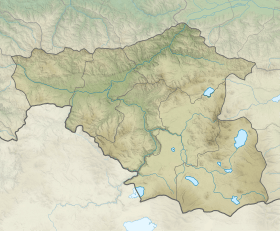Samtskhe-Javakheti
| Samtskhe-Javakheti სამცხე-ჯავახეთი | |
|---|---|
| Mkhare (region) | |
.svg.png) | |
| Country |
|
| Seat | Akhaltsikhe |
| Subdivisions |
1 self-governing city 6 municipalities |
| Government | |
| • Governor | Lasha Chkadua |
| Area | |
| • Total | 6,413 km2 (2,476 sq mi) |
| Population (2014 census) | |
| • Total | 160,262 |
| • Density | 25/km2 (65/sq mi) |
| ISO 3166 code | GE-SJ |

Samtskhe-Javakheti (Georgian: სამცხე-ჯავახეთი, Samcxe-Javaxeti, pronounced [sɑmtsʰxɛ dʒɑvaxɛtʰi]), is a region (Georgian: Mkhare) formed in the 1995 in southern Georgia from the historical provinces of Meskheti (Samtskhe), Javakheti and Tori (Borjomi gorge). Akhaltsikhe is its capital. The region comprises six administrative districts: Akhaltsikhe, Adigeni, Aspindza, Borjomi, Akhalkalaki and Ninotsminda. There are 5 town, 6 townlets, 67 community and village sakrebulos (assemblies), and 268 villages in the region. Samtskhe-Javakheti is bordered by the regions of Adjara to the west, Guria and Imereti to the north, Shida Kartli and Kvemo Kartli to the north-east and to the east, and by Armenia and Turkey to the south and southwest.
The Baku-Tbilisi-Ceyhan oil pipeline, the South Caucasus natural gas pipeline, and the Kars–Tbilisi–Baku railway (under construction) pass through the region.
History
The current division of Georgia into "regions" (Mkhare) was introduced by the Shevardnadze government in the mid-1990s, partly as a response to the secession of Abkhazia and the South Ossetia conflict. Samtskhe-Javakheti was basically formed by combining the two traditional provinces of Samtskhe and Javakheti.
Meskheti
The ancient tribes of Meskhi'" (or Moschi) and Mosiniks are the first known inhabitants of the area. Some scholars credit the Mosiniks (or Mossynoeci) with the invention of iron metallurgy. From the 2nd millennium to the 4th century BC, Meskheti was believed to be part of the Kingdom of Diaokhi, in the 4th century BC to the 6th century AD part of the Kingdom of Iberia, both as vassals of the Persian Empires. From the 10th to the 15th century it was part of the united Georgian Kingdom. In the 16th century Meskheti was integrated into the Safavid Empire, followed by the Ottoman Empire. After the conclusion of the Russo-Persian War of 1826-28, it was a part of Russian Tbilisi Governorate (Tiflisskaia Gubernia) from 1817 till 1829, from 1918 to 1921 part of the Democratic Republic of Georgia, and from 1921 to 1990 part of the Georgian SSR. After independence from the USSR Meskheti was reinstalled as a province of Georgia, and later cast into the new Samtskhe-Javakheti region.
Javakheti
In early sources, the region was recorded as Zabakha in 785 BC owned by the king Argishti I of Urartu as a conquered land. In the 1st century AD king of Kartli (Georgian Kingdom) Parsman I (Kveli) managed to take Javakheti. In the 5th century during the rule of Vakhtang V (Gorgaslani) Javakheti was a province of Iberia, and after his death his second wife the Byzantinian princess settled in Tsunda (part of Javakheti). Javakheti was an important part of the Kingdom of Kartli. In the 11th century Akhalkalaki became the center of upper Javakheti, and Tmogvi the center of lower Javakheti. Under the Georgian Kingdom (11th-13th centuries), Javakheti bridges, churches, monasteries, and royal residences (Lgivi, Ghrtila, Bozhano, Vardzia) were constructed. From the 13th century, Javakheti included the territories of Palakatsio (modern Turkey) and part of Meskheti. In the 15th century, Javakheti was governed by Samtskhe-Saatabago. In the 16th century, it became part of the Safavid Empire, followed by the Ottomans and the Persian against after. The Georgian population of Javakheti was displaced to inner regions of Georgia - part to the Imereti, and another to the Kartli. Those who remained in the place became Muslims.
As a result of the struggles of the Russian Empire with the Ottomans, Russian authorities settled Christian Armenians and Greeks in the area after 1828.[1] Armenian refugees from the Armenian genocide in the Ottoman Empire came in the early 20th century. Also a large number of Russian Doukhobor sect members settled the region.
Expulsion of Meskhetian Turks
Meskhetian Turks are the former Muslim inhabitants of Meskheti (now known as Samtskhe) in Georgia, along the border with Turkey. From November 15 to November 25, 1944, they were deported in cattle-trucks to Central Asia by order of Stalin and settled within an area that overlaps the boundaries of the modern nations of Kazakhstan, Kyrgyzstan, and Uzbekistan. Today, many are still dispersed across those countries. Of the 100,000 forcibly deported, a total of 10,000 perished.[2]
Population
.svg.png)
The Georgian census of 2014 officially recorded 160,504 inhabitants in the region, of whom 79,878 (49.5%) were Armenians, 79,065 (48.5%) were Georgians, 2,230 (1.1%) were Russians and 1,826 (0.9%) belonged to other ethnic groups.[3] The most densely populated districts are theAkhaltsikhe and Akhalkalaki municipalities. According to the 2014 census, 93% of the inhabitants of Akhalkalaki municipality and 95% of Ninotsminda municipality are Armenians.
Tourist attractions
The major tourist attractions are the cave monasteries of Vardzia (which was founded by Queen Tamar in 1185), Vanis Kvabebi (which dates from the 8th century), Rabati Castle and Khertvisi fortress. Also, among national visitors is very popular 10th century Sapara Monastery, Tmogvi fortress, and 8th century Zarzma monastery.
See also
- Subdivisions of Georgia
- Meskheti
- Javakheti
- Tori
- Gugark
- Meskhetian Turks
- Armenians in Samtskhe-Javakheti
References
- ↑ Boeschoten, Hendrik; Rentzsch, Julian (2010). Turcology in Mainz. p. 142. ISBN 978-3-447-06113-1. Retrieved 9 July 2011.
- ↑ http://www.guardian.co.uk/news/2003/apr/05/guardianobituaries.usa as retrieved on 29 Apr 2008 20:59:44 GMT
- ↑ "Ethnic groups by major administrative-territorial units" (PDF). National Statistics Office of Georgia. Retrieved 3 May 2015.
External links
- Friends at Dinner, Foes at Politics (about socio-economic problems of the region)
- Obstacles Impeding the Regional Integration of the Javalkheti Region, an ECMI working paper (PDF format)
Coordinates: 41°35′N 43°16′E / 41.583°N 43.267°E
.svg.png)